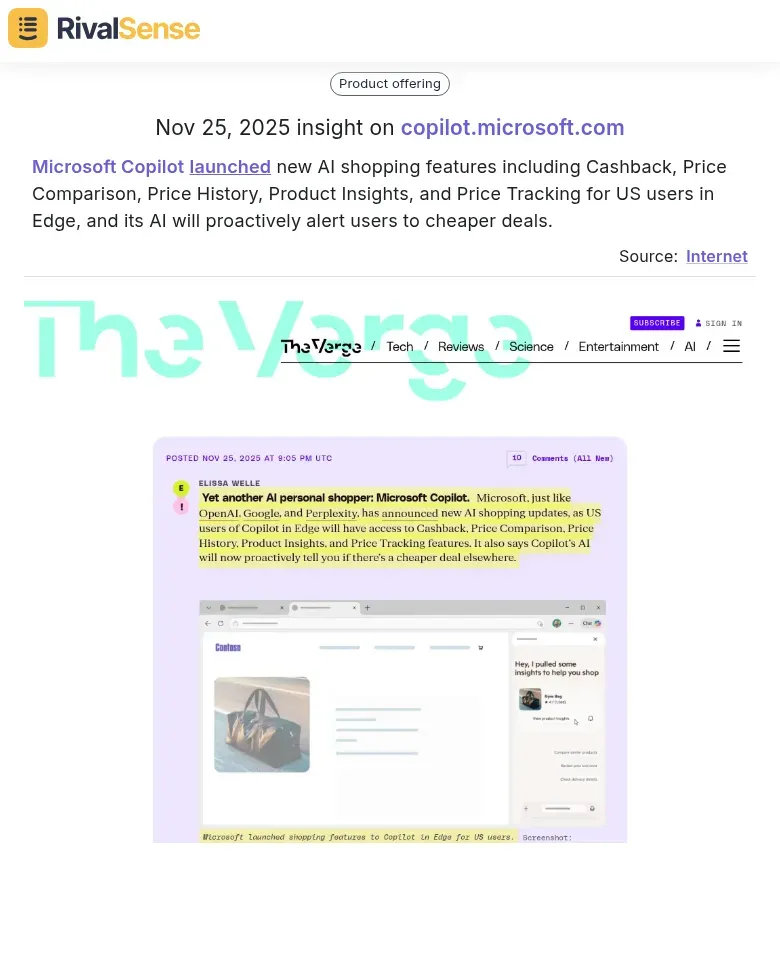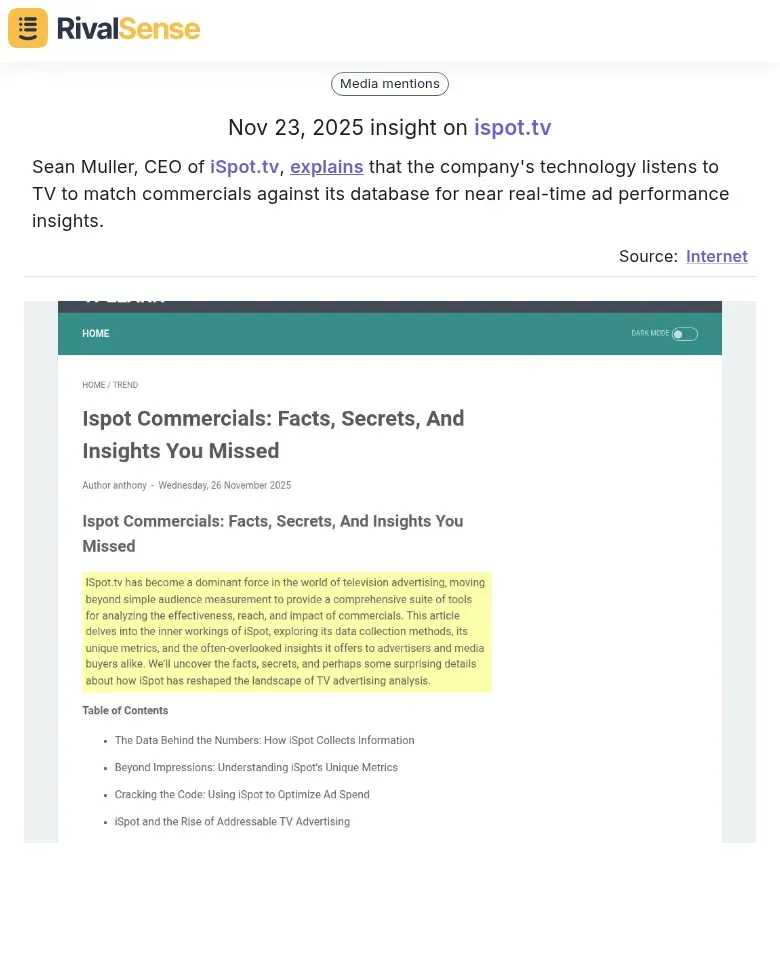2025 Competitor Intelligence Trends for Key Account Growth
In 2025, competitor intelligence is undergoing a seismic shift, driven by AI and real-time data. No longer a reactive function, it's becoming a proactive powerhouse that anticipates competitor moves before they happen. AI algorithms now analyze vast datasets—from social media sentiment to pricing changes—delivering actionable insights in real-time. This transformation is crucial for key account growth, where understanding competitor strategies helps you protect and expand your most valuable relationships.
Businesses are moving from siloed competitive analysis to integrated market intelligence. Instead of isolated reports, companies now use unified dashboards that combine competitor data with market trends, customer feedback, and internal performance metrics. This holistic view enables strategic decision-making that's both informed and timely.
🚀 Practical steps to adapt:
- ✅ Implement AI-powered monitoring tools for real-time alerts on competitor activities
- ✅ Create cross-functional teams to share intelligence across sales, marketing, and product development
- ✅ Develop a competitor response playbook for common scenarios
- ✅ Regularly update your key account strategies based on fresh competitor insights
- ✅ Use competitive intelligence to identify white space opportunities in your accounts
AI-Powered Proactive Intelligence: Learning from Market Leaders
AI-powered proactive intelligence transforms how businesses protect key accounts by anticipating competitor moves before they impact revenue. Market leaders are leveraging AI to automate monitoring and response strategies, enabling faster and more effective decision-making. For instance, RivalSense tracked that Microsoft Copilot launched new AI shopping features including Cashback, Price Comparison, Price History, Product Insights, and Price Tracking for US users in Edge, with AI proactively alerting users to cheaper deals.

This type of insight is valuable because it demonstrates how AI-driven product launches can reveal competitor innovations in real-time, allowing you to adapt your offerings and protect key accounts from being poached. Beyond structured data, AI now analyzes unstructured sources—meeting transcripts, email threads, customer feedback—to uncover hidden competitive threats. Natural language processing identifies patterns indicating competitor interest in your accounts, allowing preemptive action.
Predictive AI models forecast competitor strategies by analyzing historical data, market conditions, and public announcements. This enables automated response planning: when AI detects a competitor targeting your key account, it triggers pre-built countermeasures—customized offers, executive outreach, or enhanced service packages.
📋 Practical steps to implement:
- ✅ Integrate AI tools that monitor competitor websites, social media, and review sites
- ✅ Use sentiment analysis on customer communications to spot dissatisfaction competitors might exploit
- ✅ Develop "if-then" response templates for common competitive scenarios
- ✅ Train sales teams on AI-generated insights during account planning sessions
- ✅ Regularly update AI models with new competitive intelligence data
Real-Time Competitor Monitoring and Market Sensing
In 2025, real-time competitor monitoring and market sensing are critical for key account growth. Staying ahead requires instant access to data on competitor activities, from product launches to marketing campaigns, to pivot strategies swiftly. For example, RivalSense captured that Sean Muller, CEO of iSpot.tv, explains the company's technology listens to TV to match commercials against its database for near real-time ad performance insights.

This insight is valuable as it highlights the power of real-time data processing in uncovering competitor marketing tactics, enabling you to adjust your campaigns and safeguard key relationships before threats escalate. Use AI to detect subtle market shifts and competitor sentiment changes before they impact key accounts; for example, analyze social media, news, and review data to spot emerging trends or dissatisfaction early. Continuous market sensing helps you stay ahead of indirect competitors and emerging threats by regularly scanning for new entrants or adjacent industry moves.
🔍 Practical steps:
- ✅ Set up automated alerts for competitor mentions and updates
- ✅ Use AI tools to analyze sentiment and predict market movements
- ✅ Conduct weekly reviews of competitor data to adjust strategies
- ✅ Monitor adjacent industries for indirect competitive threats
Strategic Frameworks and Holistic Intelligence
In 2025, competitor intelligence is evolving with metamodern frameworks that blend structure and adaptability, much like educational leadership models. This approach integrates quantitative data with qualitative insights, enabling you to anticipate shifts before they happen and foster innovation in key account strategies. RivalSense reported that Yuliya Shtaltovna, a professor at Hochschule Fresenius, authored a paper proposing a metamodern framework to redefine education's role in society and leadership.

Such insights are valuable for business strategy as they encourage adopting holistic, adaptive frameworks that go beyond tracking direct rivals, helping you navigate complex market dynamics and inspire transformative growth. Move beyond tracking direct rivals to monitor adjacent industries, regulatory updates, and ecosystem dynamics—for example, a SaaS company might analyze fintech regulations impacting payment integrations. Use wargaming and scenario planning to stress-test strategies: simulate competitor responses to your moves, like price changes or feature launches, to identify vulnerabilities.
🗺️ Practical steps:
- ✅ Map your competitive landscape including indirect players and regulators
- ✅ Conduct quarterly scenario workshops with cross-functional teams
- ✅ Leverage tools for real-time alerts on market shifts
- ✅ Integrate qualitative insights from thought leaders and academic research
Data Quality, Privacy, and Ethical Intelligence Gathering
In 2025, data quality, privacy, and ethical intelligence gathering are paramount for key account growth, as inaccurate or unethical practices can lead to legal issues and damaged trust. Ensuring compliance and accuracy in data handling not only mitigates risks but also enhances the credibility of your intelligence efforts, supporting long-term account retention. Compliance with regulations like GDPR is non-negotiable; anonymize personal data, obtain consent where required, and document your processes to avoid penalties.
Balance aggressive intelligence gathering with ethics by avoiding deceptive practices—focus on publicly available data and industry reports. Build trust by being transparent about your intentions when engaging with stakeholders. Leverage synthetic data for safe experimentation; use AI-generated datasets to model competitor scenarios without real-world risks.
🛡️ Practical steps:
- ✅ Conduct regular audits of your data sources for accuracy
- ✅ Implement a compliance checklist covering GDPR and other local laws
- ✅ Train your team on ethical guidelines, emphasizing respect for intellectual property
- ✅ Use synthetic data tools to test strategies in simulated environments before execution
Implementation Roadmap: Turning Intelligence into Key Account Growth
To turn competitor intelligence into key account growth, follow this implementation roadmap, which emphasizes actionable steps and measurable outcomes. By systematically integrating insights into daily operations, you can transform data into strategic advantages that drive revenue and strengthen client relationships.
📊 Step 1: Integrate AI & Real-Time Insights
- Deploy AI tools that monitor competitor pricing, product updates, and market moves in real-time
- Use dashboards to alert your key account teams instantly—e.g., if a rival launches a feature, trigger a proactive client check-in
- Automate data collection from sources like news, reviews, and social media to reduce manual effort
🌟 Step 2: Build a Learning Culture
- Foster weekly competitor review sessions where teams discuss intelligence findings and brainstorm agile responses
- Encourage cross-department collaboration (sales, marketing, product) to align strategies
- Implement a 'test-and-learn' approach: pilot small changes based on insights and scale what works
📈 Step 3: Measure Impact
- Track metrics such as key account retention rates, expansion revenue, and overall revenue growth attributed to intelligence actions
- Use A/B testing to compare outcomes with and without competitor insights, and refine your approach based on data-driven results
💡 Practical Tip: Start with a pilot for 2-3 key accounts, use a checklist to ensure all steps are followed, and iterate based on feedback.
Ready to elevate your competitor intelligence? Try RivalSense for free at https://rivalsense.co/ to track product launches, pricing updates, and more in weekly reports—get your first competitor report today and stay ahead in 2025!
📚 Read more
👉 AI-Powered Key Account Management: A Step-by-Step Framework
👉 Step-by-Step Guide to Analyzing Competitor Event Participation
👉 Mastering Competitor Analysis: Insights from ImpactEd Group's Initiative
👉 The Ultimate Guide to Key Account Tracking Automation in 2025
👉 How to Track Competitor Funding for Supply Chain Optimization
